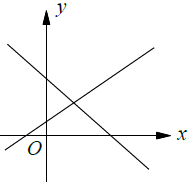ROW REDUCTION FOR A SYSTEMS OF LINEAR EQUATIONS
Subscribe to our ▶️ YouTube channel 🔴 for the latest videos, updates, and tips.
The process of solving system using elementary row operations is known as row reduction. Our aim is to perform row operations until there are all zeroes in the bottom left hand corner. At this time the system is said to be in echelon form.
Elementary row operations equivalent to the three legitimate operations with equations.
- Interchanging rows
- Replace any row by a non zero multiple of itself
- Replace any row by itself plus or minus a multiple of another row.
|
Unique solution |
 |
|
No solution |
 |
|
Infinitely many solution |
 |
Use row operations to solve the following systems of linear equations.
Problem 1 :
2x + 3y = 4
5x + 4y = 17
Solution :
In augmented matrix form the system is :
R2 --> 2R2 - 5R1
10 8 34
10 15 20
(-) (-) (-)
______________
0 -7 14
After using row reduction operation, we get the above matrix. From second row, we get
-7y = 14
Dividing by -7, we get
y = -2
From the first row,
2 x + 3y = 4
2x + 3(-2) = 4
2x - 6 = 4
2x = 4 + 6
2x = 10
x = 5
So, the required solution is (5, -2).
Problem 2 :
x - 2y = 8
4x + y = 5
Solution :
In augmented matrix form the system is :
R2 --> 4R1 - R2
4 -8 32
4 1 5
(-) (-) (-)
---------------------------
0 -9 27
After using row reduction operation, we get the above matrix. From second row, we get
-9y = 27
Dividing by -9, we get
y = -3
From the first row,
x - 2y = 8
x - 2(-3) = 8
x + 6 = 8
x = 8 - 6
x = 2
So, the required solution is (2, 3).
Problem 3 :
4x + 5y = 21
5x - 3y = -20
Solution :
In augmented matrix form the system is :
R2 --> 5R1 - 4R2
20 25 105
20 -12 -80
(-) (+) (+)
---------------------------
0 37 185
After using row reduction operation, we get the above matrix. From second row, we get
37y = 185
Dividing by 37, we get
y = 5
From the first row,
4x + 5y = 21
4x + 5(5) = 21
4x + 25 = 21
4x = 21 - 25
4x = -4
x = -1
So, the required solution is (-1, 5).
Problem 4 :
3x + y = -10
2x + 5y = -24
Solution :
In augmented matrix form the system is :
R2 --> 2R1 - 3R2
6 2 -20
6 15 -72
(-) (-) (+)
---------------------------
0 -13 52
After using row reduction operation, we get the above matrix. From second row, we get
-13y = 52
Dividing by -13, we get
y = -4
From the first row,
3x + y = -10
3x + (-4) = -10
3x - 4 = -10
3x = -10 + 4
3x = -6
x = -6/3
x = -2
So, the required solution is (-2, -4)
Problem 5 :
Use row reduction on the system
2x + 3y = 5
2x + 3y = 11
to reduce the system to
b) What does the second row indicate ?
c) Explain this result geometrically
Solution :
Since no more variable terms is no more variable terms and there is constant in echelon form, there is no solution.
b) The second row indicate that there is no solution for the system of linear equations given.
c) Since there is no solution, the lines will never meet each other and they are parallel.
Problem 6 :
a) Use row reduction to the system
2x + 3y = 5
4x + 6y = 10
to reduce the system to
b) Explain this result geometrically.
Solution :
a) By considering the second row, including variable and constants everything is 0. Then there is infinitely many solution.
b) The lines are coincident lines.
Problem 7 :
Consider the equation pair
x + 2y = 3
2x + 4y = 6
a) Explain why there are infinitely many solutions, giving geometric evidence.
b) Explain why the second equation can be ignored when finding all solutions.
c) Give all solutions in form,
i) x = ?, y = ?
ii) y = s, x = ?
Solution :
In augmented matrix form the system is :
R2 --> 2R1 - R2
2 4 6
2 4 6
(-) (-) (-)
---------------------------
0 0 0
a) The second equation is the same as the first when divided throughout by 2. The lines are coincident.
b) It gives no more information than the first..
c) Give all solutions in form,
i) When x = t
x + 2y = 3
Applying x = t, we get
t + 2y = 3
2y = 3 - t
y = (3 - t)/2
ii) When y = s
x + 2y = 3
Applying y = s, we get
x + 2s = 3
x = 3 - 2s
Subscribe to our ▶️ YouTube channel 🔴 for the latest videos, updates, and tips.
Recent Articles
-
Finding Range of Values Inequality Problems
May 21, 24 08:51 PM
Finding Range of Values Inequality Problems -
Solving Two Step Inequality Word Problems
May 21, 24 08:51 AM
Solving Two Step Inequality Word Problems -
Exponential Function Context and Data Modeling
May 20, 24 10:45 PM
Exponential Function Context and Data Modeling